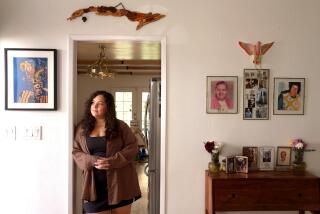Nailing Down an Occupation
- Share via
He is a beauty school dropout who dropped back in for the money.
At 6’1”, with thick sandy-blond hair and sea-foam green eyes, Sean Crockatt, a tanned, well-built 25-year-old, figures women will pay a lot of money to have him hold their hands and manicure their nails.
“I know this guy down in Orange County. He’s making $1,500 a week,” Crockatt said. “He’s pretty fair looking, and I am sure that helps.”
But the state requires that manicurists have licenses.
Licenses? For someone to file and paint your nails and push back your cuticles?
Something pre-pubescent girls have done to each other for countless generations?
Yep. Nails are a serious business.
Let’s say a customer wants fake nails, or in the language of the trade, acrylics. If real nails are wet when the acrylics are glued on, compressed fungus can grow underneath them, like so much mold on the bottom of a bathmat.
Or if her manicurist’s equipment was improperly sterilized, the would-be glamour girl could be bedridden for weeks with a bacterial infection.
So the state can’t let just anyone polish your pinkies.
Licensed manicurists complete 50 hours of onyxology, the study of nails--including study of sterilization, sanitation and bacteriology; the bones, muscles, circulatory system and nerves of the hands and arms; manicuring techniques; pedicuring; artificial nails; glands and skin conditions.
They also must spend 120 hours practicing the techniques before they begin their professional career.
And so, driven by hopes of making a lot of money, Crockatt is attending a 10-week onyxology class at the West Valley Occupational Center in Woodland Hills.
Each morning at 8 a.m., students from all departments--manicuring, facials, haircutting--punch in on a time-clock in a mock beauty parlor.
Above the clock, a poster depicts clawed hands clasping an Oriental fan and a pot of delicately-arranged chrysanthemums, urging budding manicurists to try “Dragon Lady Nails” for their clients. A hand-printed sign advertised for sale a “virgin head with long hair,” a model head equipped wig-like with real human hair which had never been colored or subjected to a permanent or other damaging embellishment.
Near the advertisements, a memo from the State Department of Consumer Affairs sternly warns that “any student who performs unlicensed services is putting his future license in jeopardy and may also face criminal prosecution.”
Do a nail, go to jail!
Though this is no prep school, the students must comply with a dress code. Each wears a uniform of black leggings, a tight blouse or T-shirt, and a white doctors coat. It is in the nails, however, that students express their diversity.
Some nails are raw and bitten; others artificially lengthened. A dark-haired girl who wears an Earth Day button on her coat has painted her nails bright green with black peace symbols. Two students have a matching polish pattern: mostly hot pink--with black and chartreuse triangles at the tips.
Into this arena strides Crockatt, a man among girls.
Crockatt was enrolled in the program about four years ago, when he was 20, but dropped out because he was living at home, and his parents were too strict.
“I lost all my freedom. They wanted me to come home right after school and study. I just couldn’t hang,” he said. After dropping out, he returned to his previous profession--house painting--but he tired of that.
His classmates now are an odd mixture. Some appear to be recent prom queens, with perms and perfect makeup, who probably spent years painting their own nails and now want to help the less fortunate have hands as elegant as theirs.
But some have reasons for going to beauty school that even hardened nail biters can appreciate.
Dana is a former college student who dropped out when she started getting acting jobs. That lasted nearly two years, but things slowed down, and now she needs to earn a little extra money while remaining free to audition. Manicuring, with its potential for a flexible schedule, seemed just the thing.
Demianne taught computer graphics at a vocational college downtown for more than five years. The stabbing of a colleague in the parking lot convinced her it was time for a career change.
“There were teachers down there who were getting assaulted for giving students Cs,” she said.
Class begins with an hour of theory, taught by a vivacious woman who once ran her own salon.
She makes a valiant effort to keep the class interested, but the lecture is disturbed by a loud clicking in the back of the room--one of the students has begun clipping her nails.
“Just hold off on this ‘til a little bit later,” the teacher says firmly.
Crockatt participates enthusiastically in class discussion, which touches on subjects from bacteria to head lice. Then students begin their practice manicures; Crockatt volunteers to demonstrate his abilities for a visitor.
He lays out his equipment on the tray before her then gently picks up her hand. As he manipulates her fingers, then massages her hands and arms, his green eyes gaze into hers.
“See,” he said, triumphantly. “Isn’t this better than a manicure from a woman?
“I want to go all the way in this business.”


